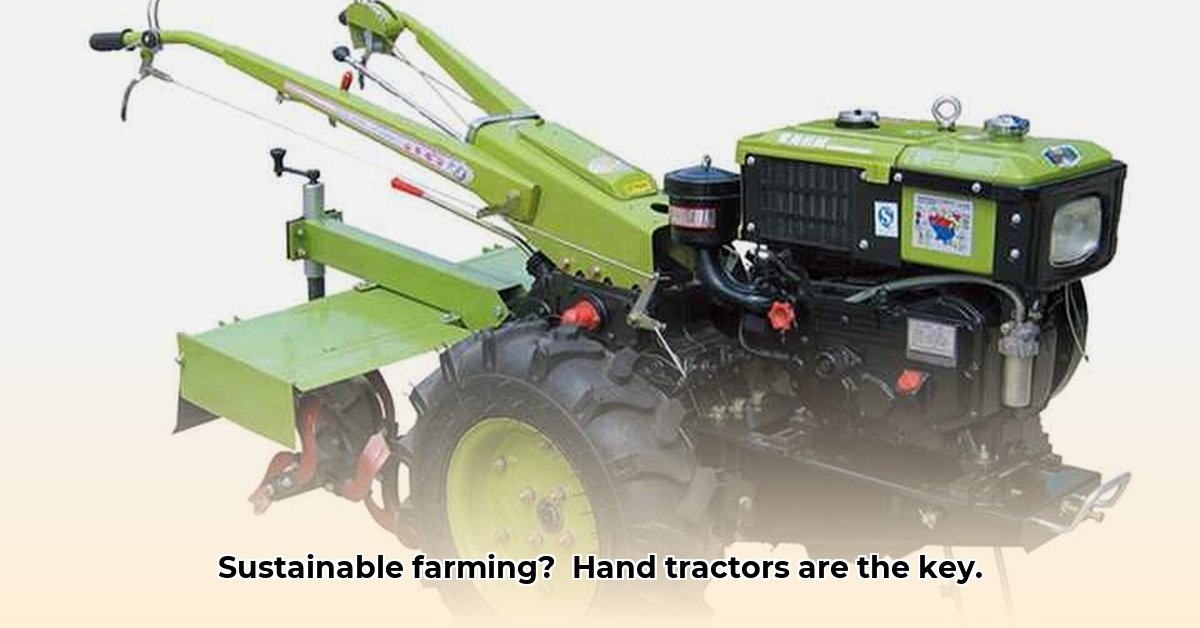
Choosing the Right Hand Tractor for Your Sustainable Farm
Sustainable farming practices are gaining momentum, and selecting the appropriate equipment is paramount. Hand tractors, with their maneuverability and efficiency, are becoming increasingly popular among environmentally conscious farmers. This guide will help you navigate the process of choosing, maintaining, and financing a hand tractor to enhance your sustainable farming operation.
How can you ensure you select the most efficient hand tractor for your sustainable farming needs? A key consideration is matching tractor capabilities to your specific farm conditions. For cost comparisons, check out tractor pricing.
Power and Attachments: Matching Your Needs
The selection process begins with assessing your farming tasks and budget. Horsepower (the tractor's power) determines its capacity for heavy tasks like plowing dense soil. More horsepower often translates to greater fuel consumption and a larger environmental impact. However, lighter tasks might be perfectly suited to a lower horsepower model. Striking a balance between power and efficiency is key.
Equally important is considering the necessary attachments. Do you require a tiller for soil preparation, a plow for initial land clearing, or a sprayer for pesticide/fertilizer application? Many tractors offer interchangeable attachments, ensuring versatility and cost-effectiveness over time.
Dr. Emily Carter, Agricultural Engineering Professor at Cornell University, emphasizes: "Choosing the right attachments is as crucial as choosing the tractor itself. A versatile machine with easily interchangeable components can significantly reduce long-term costs and improve operational efficiency."
Fuel Efficiency and Maintenance: Long-Term Sustainability
Fuel efficiency is vital for both financial and environmental reasons. A fuel-efficient hand tractor translates to lower operational costs and a smaller carbon footprint. Research tractors with high fuel-efficiency ratings and consider the environmental impact of the fuel type itself (e.g., biodiesel).
Simple maintenance is equally important. Easy access to parts, straightforward designs, and the availability of experienced local mechanics will minimize downtime and expenses. "A well-maintained hand tractor can operate reliably for many years," says James Miller, a veteran farmer from Iowa. "Regular servicing is critical for longevity and optimal performance."
Hand Tractors: A Balanced Perspective
Hand tractors offer numerous advantages but also have limitations. Understanding both sides of the coin is crucial for a well-informed investment decision.
| Advantage | Disadvantage |
|---|---|
| Excellent maneuverability | Lower horsepower |
| Fuel efficiency | Limited capacity |
| Lower initial cost | Potential for more manual labor |
| Relatively easy maintenance | Fewer available attachments |
Hand Tractors and Sustainable Farming Practices
Hand tractors align exceptionally well with several sustainable farming methods:
Precision Farming: The precise application of fertilizers and pesticides minimizes waste and environmental impact, leading to cost savings.
No-Till Farming: Many hand tractors are compatible with no-till farming, preserving soil health, reducing erosion, and promoting biodiversity.
Crop Diversity: Maneuverability allows for efficient management of diverse crops, facilitating polyculture farming systems.
Reduced Carbon Footprint: Fuel efficiency contributes to a smaller overall carbon footprint.
The Future of Hand Tractors: Technological Advancements
The hand tractor market is constantly evolving. Key innovations include:
- Electric and Hybrid Power: Offering quiet operation, reduced emissions, and lower running costs.
- Smart Technology: Automation and GPS integration enhance precision farming.
- Data Integration: Farm management software integration provides data for optimized decision-making.
Given the rapid pace of technological advancements, staying abreast of the latest developments is essential for making informed choices.
Financing Your Sustainable Farming Equipment
Securing funding for sustainable agriculture equipment is crucial, especially for smaller farms. Various financing options exist beyond the USDA:
USDA Programs: Explore programs like microloans, Farm Storage Facility Loans, and cost-share programs, although navigating their complexities can be challenging.
Private Lenders: Banks and credit unions may offer farm equipment loans; some even specialize in sustainable agriculture.
Grants and Foundations: Several private organizations offer grants for sustainable agriculture initiatives.
Leasing: Consider leasing equipment to avoid large upfront investments.
Crowdfunding: Directly raise funds from supporters.
Choosing a hand tractor requires careful consideration of factors such as horsepower, attachments, fuel efficiency, and maintenance requirements. By understanding the interplay of these elements, you can significantly improve the sustainability and efficiency of your farm.